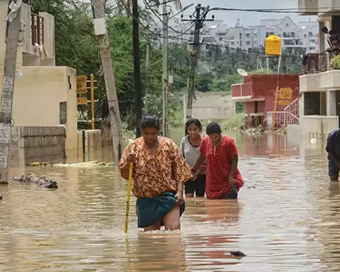 PM Modi visit USA
PM Modi visit USA Only the mirror in my washroom and phone gallery see the crazy me : Sara Khan
Only the mirror in my washroom and phone gallery see the crazy me : Sara Khan Karnataka rain fury: Photos of flooded streets, uprooted trees
Karnataka rain fury: Photos of flooded streets, uprooted trees Cannes 2022: Deepika Padukone stuns at the French Riviera in Sabyasachi outfit
Cannes 2022: Deepika Padukone stuns at the French Riviera in Sabyasachi outfit Ranbir Kapoor And Alia Bhatt's Wedding Pics - Sealed With A Kiss
Ranbir Kapoor And Alia Bhatt's Wedding Pics - Sealed With A Kiss Oscars 2022: Every Academy Award Winner
Oscars 2022: Every Academy Award Winner Shane Warne (1969-2022): Australian cricket legend's life in pictures
Shane Warne (1969-2022): Australian cricket legend's life in pictures Photos: What Russia's invasion of Ukraine looks like on the ground
Photos: What Russia's invasion of Ukraine looks like on the ground Lata Mangeshkar (1929-2022): A pictorial tribute to the 'Nightingale of India'
Lata Mangeshkar (1929-2022): A pictorial tribute to the 'Nightingale of India' PM Modi unveils 216-feet tall Statue of Equality in Hyderabad (PHOTOS)
PM Modi unveils 216-feet tall Statue of Equality in Hyderabad (PHOTOS)The Badminton Association of India (BAI) has announced a 14-member-strong India squad for
- Men’s Sr Hockey Nationals to be played in division-based format from April 4
- Mensik denies Djokovic 100th title in Miami final
- KIPG: Son of a vegetable vendor, Bihar’s Jhandu Kumar eyes Worlds, 2028 Paralympics
- Hardik Singh credits hard work and team unity for receiving HI Midfielder of the Year award
- Djokovic, Alcaraz land in same half of Miami draw
Sanitising cattle sheds key to prevent malaria in India Last Updated : 16 Jan 2017 06:26:15 PM IST 
(File Photo)
Targetting mosquitoes responsible for transmission of malaria that take refuge in cattle sheds in countries like India can help achieve WHO's goal of eliminating the disease globally by 2030, researchers say.
The study found the mosquitoes transmitting malaria often rest within cattle sheds that are next to and sometimes even share a wall with human houses, yet current control efforts are only restricted to domestic dwellings only.
The study emphasised an urgent need for mosquito-control efforts to take into account the relationship between mosquitoes and cattle.
"We found that in an area of India that has a high burden of malaria, most of the mosquitoes that are known to transmit malaria rest in cattle sheds and feed on both cows and humans," said Matthew Thomas, Professor at Pennsylvania State University (Penn State) in the US.
"Understanding the dynamic between humans, cattle and mosquitoes could have major implications for malaria control policy and practice, not only in India, but in other areas where transmission is sustained by zoophilic vectors," Thomas added.
For the study, the team collected a total of 1,774 Anopheles culicifacies and 169 Anopheles fluviatilis mosquitoes species -- major vectors of malaria on the Indian subcontinent -- from six villages in Odisha -- which has the highest number of malaria cases in India.
They found both species were denser in cattle sheds than in human dwellings and both were feeding on humans and cattle.
The researchers built a computer model that simulated the life of an adult mosquito and showed that conventional control tools such as insecticide-treated bed nets and indoor insecticide sprays are less effective when mosquitoes exhibit 'zoophilic' behaviours -- having an attraction to non-human animals.
"However, broadening coverage of non-repellent insecticide sprays to include cattle sheds could help reduce transmission dramatically," Thomas said.
Importantly, the model revealed that directing even modest amounts of effort to specifically increase cattle-based mosquito mortality associated with zoophilic behaviour can shift the balance towards elimination," the researchers stated.
The findings appear in the journal Scientific Reports.IANS For Latest Updates Please-
Join us on
Follow us on








172.31.16.186







